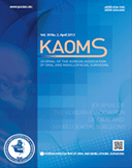Journal of the Korean Association of Oral and Maxillofacial Surgeons
- P-ISSN2234-7550
- E-ISSN2234-5930
- SCOPUS, KCI, ESCI
 ISSN : 2234-7550
ISSN : 2234-7550
한국인 악안면 외상 환자 581명의 원인과 양상에 관한 연구
Etiology and Patterns of Maxillofacial Fractures in 518 patients in Korea
이은경 (보라매병원)
유정규 (보라매병원)
박창주 (한양대학교)
송승일 (아주대학교)
황경균 (한양대학교)
Abstract
Purpose: Different patterns in the causes of maxillofacial injury are thought to correlate with socioeconomic status and regional environment. This study investigated maxillofacial fractures in order to analyze maxillofacial trauma characteristics and the relationship between the causes and injury patterns in Korea. Material and methods: A total of 518 patients with maxillofacial fractures who were treated at the Seoul National University Boramae Hospital between 1996 and 2004 were retrospectively analyzed. Data were obtained from the patients’ medical records and radiographs. The male to female ratio in the patient group was 2.78:1, and the mean age was 32.3 years. Results: Midfacial fractures were the most common location of injury (46.1%). The most common etiologic factor was an activity associated with daily life (42.6%) including falls, stumbling, and collisions. The second most common cause was assault (32.4%), followed by traffic accidents (13.7%). In the case of midfacial fractures and mandibular fractures, assault was the most common etiologic factor, whereas in the case of alveolar bone fractures, activities associated with daily life were the most common cause. With regard to age groups, assault was the most common cause for patients between 10 and 39 years old and an activity associated with daily life was the most common cause in those under 10 years and over 40 years. Conclusions: This study concluded that activities associated with daily life and assault causes a large proportion of Korean maxillofacial injuries and that preventive measures should be implemented in order to minimize these risks.
- keywords
- Maxillofacial fractures, Etiology, Midfacial fractures, Mandibular fractures, Alveolar bone fractures, Maxillofacial fractures, Etiology, Midfacial fractures, Mandibular fractures, Alveolar bone fractures
- 48다운로드 수
- 143조회수
- 0KCI 피인용수
- 0WOS 피인용수